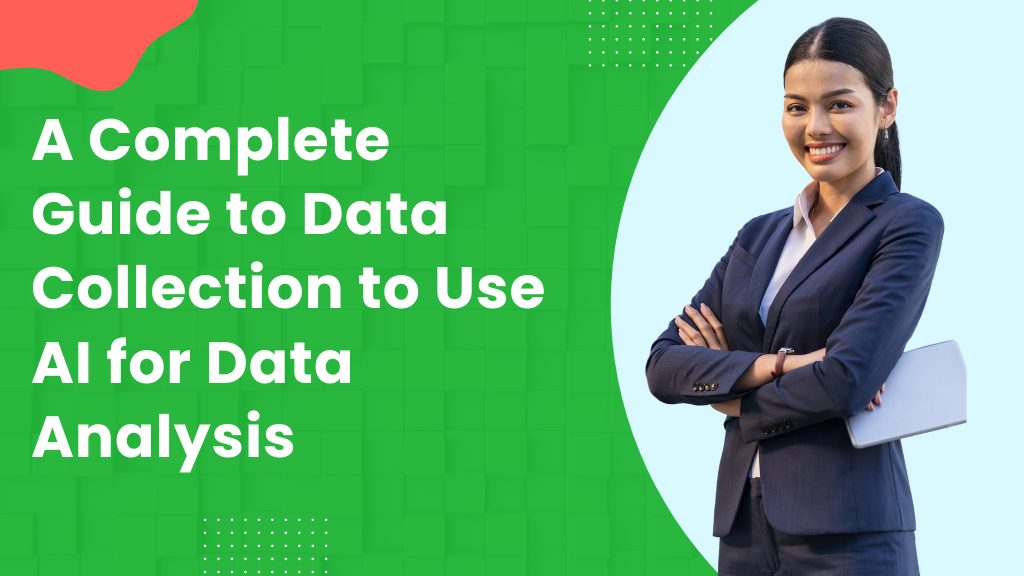As AI advances, more businesses are adopting it to analyze data collection. With all the positive reviews coming in, there’s no doubt that these businesses are uncovering patterns, trends, and predictions manual tactics often miss.
However, businesses report having found using AI for data analysis challenging at first, especially figuring out the data collection part.
You see, collecting data for AI-driven analysis varies widely from using it in spreadsheet applications. For instance, while spreadsheet applications can do without data preprocessing, you must preprocess data to use AI for data analysis.
Well, if you are stuck figuring out how to collect data for AI data analysis, this piece is for you. Here is a complete guide for you to ensure you don’t miss out on all the benefits the other businesses enjoy.
Define the Problem and AI Model Data Collection Requirements

Before you start collecting data for AI-powered analysis, you must have a clear understanding of the business problem. Do you want to predict sales, optimize lead generation, or elevate product recommendation?
Ensure you have a problem statement highlighting the current situation, the problem, its impact, and the desired improvement or solution.
After developing a detailed problem statement, select a machine learning model known to solve problems of the same nature as yours. Building a data analysis AI model from scratch is usually costly. So, you are better off working with the available models first.
Research the functionality of the models available in the market. These models learn differently, with some taking the supervised, unsupervised, or reinforcement learning approach.
Moreover, each model works with varied data including text, videos, or images — structured, semi-structured, or unstructured. Some of the models require historical data while some handle real-time data. Overall, you must patiently study the data requirements of the select model, including the data volume it can handle.
Generate More Leads With Website & Messenger Chatbots
Gather quality leads on autopilot and 10x your ROI with automated chats
Settle on a Data Collection Technique and Strategize

With a solid understanding of the business problem and the AI model data needs, you now need to select a suitable data collection technique. Here are some data collection techniques to select from:
- Web scraping: Involves getting data from websites with the help of a curated scraper. You have the option of building a scraper from scratch or using a ready made one to collect data for AI. Yes, there are scraper providers who may also help you discover, collect, and curate web data for AI. Remember, if you do decide to go the manual scraping way, always scrape websites ethically to avoid legal trouble.
- Using APIs to collect data: APIs (Application Programming Interfaces) are meant to give you access to structured data on various platforms like financial or social media platforms. They are great for collecting regularly updated and large data volumes for trend identification or predictive analysis, and when paired with dynamic web scraping, they can help fill gaps where APIs fall short by capturing real-time, complex site content.
- Surveys and questionnaires: This technique is suitable for collecting data directly from the source — the customer, general public, or employees. To derive accurate and in depth insights from surveys and questionnaires, ensure the questions are clear, concise, and relevant. Remember, open-ended questions allow for richer, more qualitative responses while closed-ended questions allow for easily analyzable and quantitative responses.
- Obtaining data from internal databases: This tactic comes in handy whenever you need data to solve unique business operational problems. For instance, you may use readily available customer information to supercharge personalized or targeted marketing, enhancing your competitive edge. As the numbers say, 29% of marketing executives that are already using AI plan to boost investment in AI.
- Synthetic data generation: If you realize the data you need is unavailable, costly, or sensitive, you have the option of generating data using simulations or algorithms mimicking real world scenarios. Moreover, you can use synthetic data generators to diversify collected data. However, note that the quality of the generated data depends on the quality of the initial data or parameters of the real-world scenario.
Ensure to select a data collection technique that aligns with your analysis goals and the outlined requirements of the select AI model. Then, define a strategy outlining how you are going to collect the data, clean it, and preprocess it as per the requirements.
Data Collection Techniques
Reference the data collection strategy and begin executing. While at it, anticipate challenges like data availability, data compliance and privacy, and data integration benefits, which can improve operational efficiency and decision-making.
Even after carefully considering all your options and settling on a specific data collection tactic, you may realize that the data you need does not exist.
Sometimes, you may discover that the data is proprietary or inaccessible because of organizational constraints or technical issues.
When this happens, consider an alternative source. Nevertheless, ensure the alternative sources satisfy the AI model’s data requirements and your end goal.
In case you need to integrate or merge data from two sources, note that you may experience technical challenges due to differences in data structures, standards, and formats. Consider using techniques like data transformation and normalization to solve such challenges.
Moreover, as you collect data, you must adhere to the defined data privacy and compliance standards. Failure to comply may land you into legal issues or lead to reputational damage.
Clean and Preprocess the Data Collection

Just as outlined in the data collection strategy, prepare the data for AI-driven analysis. This phase involves multiple steps aimed at ensuring data consistency, improving data quality, and preparing datasets to facilitate the AI model’s learning process.
Start with handling missing data and dealing with outliers. While missing values skew model results, outliers distort data patterns, leading to poor performance of the model in real-word scenarios. So, use tactics like medium imputation and outlier capping to fill the missing gaps and eliminate outliers respectively.
Then, you can preprocess the data based on the select AI model. Some models require data splitting into training, evaluation, and testing datasets. Some need you to standardize, normalize and transform the data. Go through the model’s documentation to determine the data preprocessing requirements.
Store and Manage the Data

After collecting the data, find a storage solution that allows you store and manage the data’s availability, security, and integrity. Established cloud providers like Google and AWS offer such solutions, allowing you to scale whenever you desire. To ensure scalability doesn’t come with excessive expenses, implementing AWS cloud cost optimization helps manage and reduce storage and processing costs while maintaining performance and security.
Cloud storage systems also provide you with extra data processing and analysis tools besides making retrieval of data easier. Incase of a disaster, the cloud provider helps you regain access to the data thanks to timely and regular backups.
You may also store the data in an in-house datacenter. Either way, always implement security features like access control to protect the data from unauthorized entities.
Also, consider encrypting the data to make access harder even after a data breach — a survey showed that in a period of 18 months, 80% of participating businesses admitted having experienced a data breach at least once.
Finally, you figure out a way to allow the AI model access to the data so that it can learn from it. For example, in supervised learning, the model learns from input data paired with the correct output. The goal is to have it understand the relationship between the inputs and outputs so that it can predict outcomes when exposed to new or unseen data.
Closing Words
Would you be okay with missing out on the opportunity to derive robust and more accurate insights through AI-powered data analysis? Thought so too!
The reign of AI in the data analytics space has just started. And, many businesses are not going to relent until they figure out the whole process. Cut down on the time and resources you’d spend on figuring out the process of data collection for AI-driven analysis with the help of this guide. Remember, the competition is fierce — so secure your data.
Are You Ready To SkyRocket Your Business With Our AI Chatbots
Click The Button Below And Gather Quality Leads With Botsify

